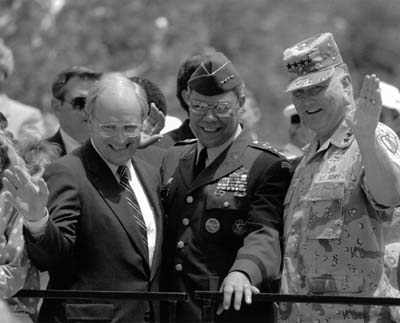
Patrick J. Sloyan, 25 November 2002, AlterNet
Leon Daniel, as did others who reported from Vietnam during the 1960s, knew about war and death. So he was puzzled by the lack of corpses at the tip of the Neutral Zone between Saudi Arabia and Iraq on Feb. 25, 1991. Clearly there had been plenty of killing. The 1st Infantry Division (Mechanized) had smashed through the defensive front-line of Saddam Hussein's army the day before, Feb. 24, the opening of the Desert Storm ground war to retake Kuwait. Daniel, representing United Press International, was part of a press pool held back from witnessing the assault on 8,000 Iraqi defenders. "They wouldn't let us see anything," said Daniel, who had seen about everything as a combat correspondent. The artillery barrage alone was enough to cause a slaughter. A 30-minute bombardment by howitzers and multiple-launch rockets scattering thousands of tiny bomblets preceded the attack by 8,400 American soldiers riding in 3,000 M1A2 Abrams main battle tanks, Bradley fighting vehicles, Humvees, armored personnel carriers and other vehicles.
It wasn't until late in the afternoon of Feb. 25 that the press pool was permitted to see where the attack occurred. There were groups of Iraqi prisoners. About 2,000 had surrendered. But there were no bodies, no stench of feces that hovers on a battlefield, no blood stains, no bits of human beings. "You get a little firefight in Vietnam and the bodies would be stacked up like cordwood," Daniel said. Finally, Daniel found the Division public affairs officer, an Army major. "Where the hell are all the bodies?" Daniel said. "What bodies?" the officer replied.
Daniel and the rest of the world would not find out until months later why the dead had vanished. Thousands of Iraqi soldiers, some of them alive and firing their weapons from World War I-style trenches, were buried by plows mounted on Abrams main battle tanks. The Abrams flanked the trench lines so that tons of sand from the plow spoil funneled into the trenches. Just behind the tanks, actually straddling the trench line, came M2 Bradleys pumping 7.62mm machine gun bullets into the Iraqi troops. "I came through right after the lead company," said Army Col. Anthony Moreno, who commanded the lead brigade during the 1st Mech's assault. "What you saw was a bunch of buried trenches with people's arms and legs sticking out of them. For all I know, we could have killed thousands."
A thinner line of trenches on Moreno's left flank was attacked by the 1st Brigade commanded by Col. Lon Maggart. He estimated his troops buried about 650 Iraqi soldiers. Darkness halted the attack on the Iraqi trench line. By the next day, the 3rd Brigade joined in the grisly innovation. "A lot of people were killed,"' said Col. David Weisman, the unit commander.
One reason there was no trace of what happened in the Neutral Zone on those two days were the ACEs. It stands for Armored Combat Earth movers and they came behind the armored burial brigade leveling the ground and smoothing away projecting Iraqi arms, legs and equipment. PFC Joe Queen of the 1st Engineers was impervious to small arms fire inside the cockpit of the massive earth mover. He remained cool and professional as he smoothed away all signs of the carnage. Queen won the Bronze Star for his efforts. "A lot of guys were scared," Queen said, "but I enjoyed it." Col. Moreno estimated more than 70 miles of trenches and earthen bunkers were attacked, filled in and smoothed over on Feb. 24-25.
Schwarzkopf repeatedly brushed off questions about the Iraqi death toll when the ground war ended in early March. Not until 2000, during a television broadcast, would he estimate Iraq losses in the "tens of thousands." The only precise estimate came from Cheney. In a formal report to Congress, Cheney said U.S. soldiers found only 457 Iraqi bodies on the battlefield. To Cheney, who helped Bush's approval rating soar off the charts during Desert Storm, the press coverage had been flawless. "The best-covered war ever," Cheney said. "The American people saw up close with their own eyes through the magic of television what the U.S. military was capable of doing."
FULL ARTICLE....






No comments:
Post a Comment